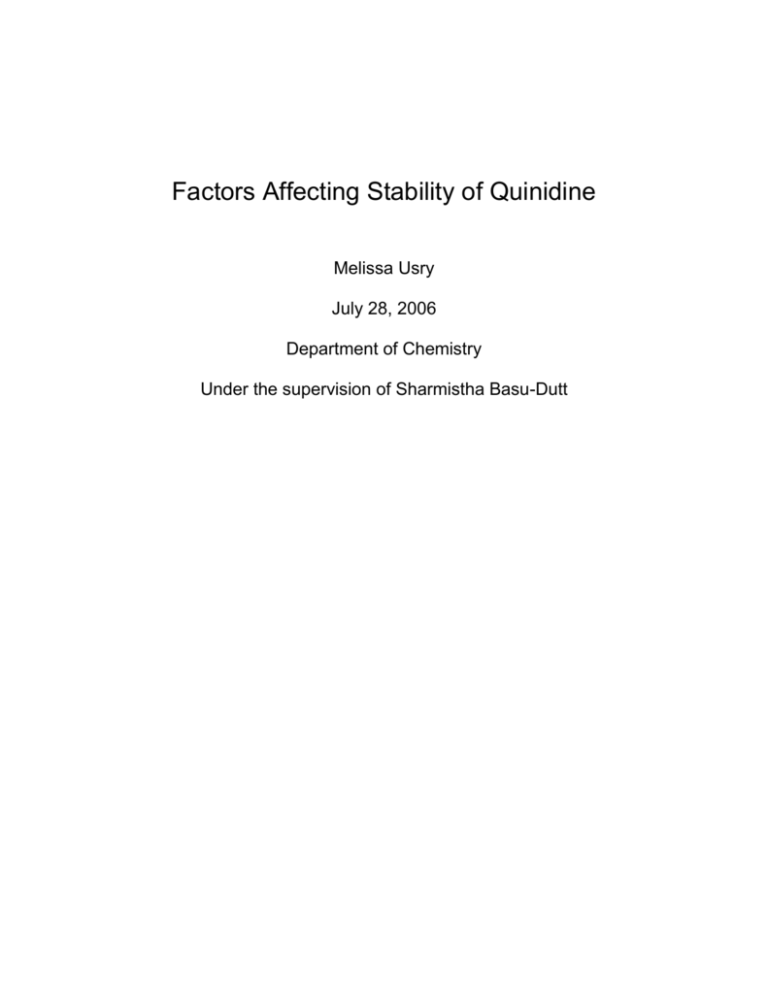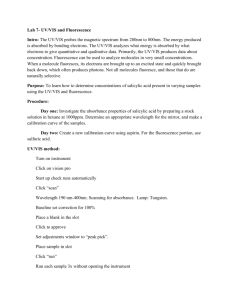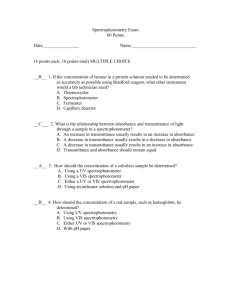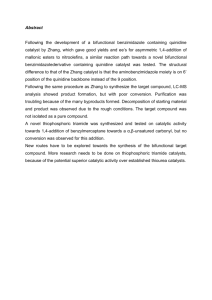Factors Affecting Stability of Quinidine
advertisement

Factors Affecting Stability of Quinidine Melissa Usry July 28, 2006 Department of Chemistry Under the supervision of Sharmistha Basu-Dutt Quinidine is a prescription drug used to treat abnormal heart rhythms. The medication regulates the flow of sodium into heart cells helping to return the heart to a regular pace and assisting in maintaining normal heartbeat. Like all drugs, Quinidine is packaged with specific storage instructions containing the proper method for handling the product. The pharmacist, as well as the patient, must be aware of risks associated with improper handling or storage of the drug. The purpose of this study was to determine the effects of stressed conditions on the Quinidine medication. Over the course of the experiment, the stability of Quinidine is reported under stressed conditions of pH, temperature and presence of alcohol. The procedures include placing a sample solution of quinidine under various stressed conditions, and analyze the results due to these alterations. The first step in this process was to prepare the stock solution, which consisted of ten milligrams of pure quinidine added to ten milliliters. In order to complete the stock solution, the dilution must be ten folded by adding nine milliliters of water to one milliliter of the pure quinidine solution. Using this stock solution, the diluted solutions are prepared by taking 0.2 milliliters, 0.5 milliliters, 1 milliliter, and 2 milliliters, and placing them in four individual test tubes. Lastly, water is added to each to formulate a final volume of five milliliters. These diluted solutions were used to generate the calibration curve based on the data reported by the UV/Vis Spectrophotometer. Samples of each solution, beginning with the ten fold stock solution, were placed in a cuvette, which was then inserted into the UV/Vis Spectrophotometer. A scan of wavelengths ranging from 280 to 340 nanometers was tested, and the wavelength at which the maximum absorbance occurred was designated λmax. The absorbance resulting from each solution is plotted on a graph, and a best fit line was drawn between the various points. The equation of this line was used to calculate the concentrations of the samples based on their absorbance ratios. After obtaining the calibration curve, the samples were placed under assorted stressed conditions. The first stressed condition tested was the increase of temperature. A sample of the stock solution was heated, and examined at various temperatures using the UV/Vis. The absorbance rates, and therefore the concentrations, at each elevated temperatures were recorded. The second stressed condition tested was the change of pH in the solution. This experiment began by first finding the pH of the original stock solution using a pH probe. Next, drops of base were added to the solution with the pH being tested after each addition, and the degraded sample tested using the UV/Vis. The same steps were followed with an acid, and the resulting concentrations recorded. The last stressed condition placed on the quinidine solution was the addition of alcohol. As drops of alcohol were added, the sample was tested in the UV/Vis, and the change in concentrations recorded. After placing the solution under these different stressed conditions, the change in concentrations of each experiment were plotted individually on a graph using Excel. A polynomial curve fitting was used to obtain polynomial coefficients to study the impact of these various factors on the stability of Quinidine. These coefficients were analyzed, and were the basis of the results formulated. The UV/Vis Spectrophotometer was an important machine used over the course of these research experiments. The particular Spectrophotometer used in these trials was a Jasco V-570. The UV/Vis Spectrophotometer is a machine used to test the absorbance ratios of certain compounds using ultraviolet and visible light beams. A sample beam is passed through a small transparent container (cuvette) containing a solution of the compound being studied in a transparent solvent. A reference beam is passed through an identical cuvette containing only the solvent. The intensities of these light beams are then measured by electronic detectors and compared. Absorbance is displayed on the vertical axis, while the UV and/or visible region scanned is shown on the horizontal axis. The UV region tested is generally from 200 to 400 nm. The wavelength of maximum absorbance is a characteristic value, designated as λmax. The machine is connected to a computer, where the results of the scan are presented and analyzed. The information presented through the UV/Vis suggested the wavelength at which the maximum absorbance occurred was 331 nanometers. Therefore, the change in absorbance for each experiment was recorded at this point. The graphs formulated using Excel were finally analyzed. Each of the graphs revealed a loss of stability leading to a concentration decrease according to a 3rd order polynomial. Also, the coefficients of the regression equations formed by each trend line were studied, and revealed that the stressed conditions of pH affected the stability of Quinidine the most. Furthermore, the change of pH in the solution caused a shift in the λmax, therefore indicating the formation of a new product. This was the extent of results reached based on the research completed at the conclusion of the summer semester program. The discovery of the shift due to pH led to the plans for future projects using a GC-MS. Also, the trials will be tested a second time to verify results formulated during these experiments. Furthermore, plans to continue further research into this study are in effect and will be reported following the Fall semester.






